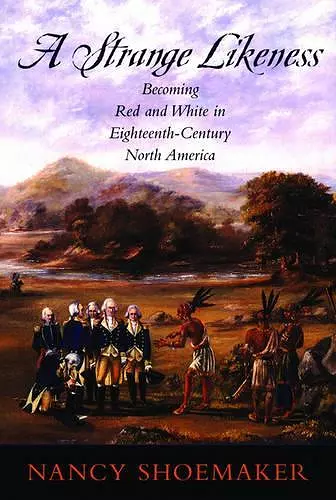A Strange Likeness
Becoming Red and White in Eighteenth-Century North America
Format:Paperback
Publisher:Oxford University Press Inc
Published:25th May '06
Currently unavailable, and unfortunately no date known when it will be back

The relationship between American Indians and Europeans on America's frontiers is typically characterized as a series of cultural conflicts and misunderstandings based on a vast gulf of difference. Nancy Shoemaker turns this notion on its head, showing that Indians and Europeans shared common beliefs about their most fundamental realities--land as national territory, government, record-keeping, international alliances, gender, and the human body. Before they even met, Europeans and Indians shared perceptions of a landscape marked by mountains and rivers, a physical world in which the sun rose and set every day, and a human body with its own distinctive shape. They also shared in their ability to make sense of it all and to invent new, abstract ideas based on the tangible and visible experiences of daily life. Focusing on eastern North America up through the end of the Seven Years War, Shoemaker closely reads incidents, letters, and recorded speeches from the Iroquois and Creek confederacies, the Cherokee Nation, and other Native groups alongside British and French sources, paying particular attention to the language used in cross-cultural conversation. Paradoxically, the more American Indians and Europeans came to know each other, the more they came to see each other as different. By the end of the 18th century, Shoemaker argues, they abandoned an initial willingness to recognize in each other a common humanity and instead developed new ideas rooted in the conviction that, by custom and perhaps even by nature, Native Americans and Europeans were peoples fundamentally at odds. In her analysis, Shoemaker reveals the 18th century roots of enduring stereotypes Indians developed about Europeans, as well as stereotypes Europeans created about Indians. This powerful and eloquent interpretation questions long-standing assumptions, revealing the strange likenesses among the inhabitants of colonial North America.
In his impressive elucidation of the Old English verse features which Pound carries through to his 'Saxonist prosody', Jones makes a hefty, lasting contribution to our enjoyment of parts of Pound's sharply sensory, taut and restrained free verse... [Jones's book] is erudite and deeply informed, drawing on years of research and reflection... intellectually convincing, while most valuable, perhaps, for its astute and responsive treatment of particular poems. Strange Likeness has stimulated my own search for finds: among the four major poets Jones looks at closely, in the books of those he glances at in passing, and among those younger generations to whom Pound, Auden, Morgan and Heaney hand on both models to follow and spurs to creativity. * Anthony Moore, Essays in Criticism *
One of the book's strengths is its attentiuon to many Indian peoples, especially those in the American South, who usually attract less notice ... very readable ... a worthwhile book. * Philip Ranlet, History Journal *
ISBN: 9780195307108
Dimensions: 233mm x 162mm x 16mm
Weight: 345g
224 pages